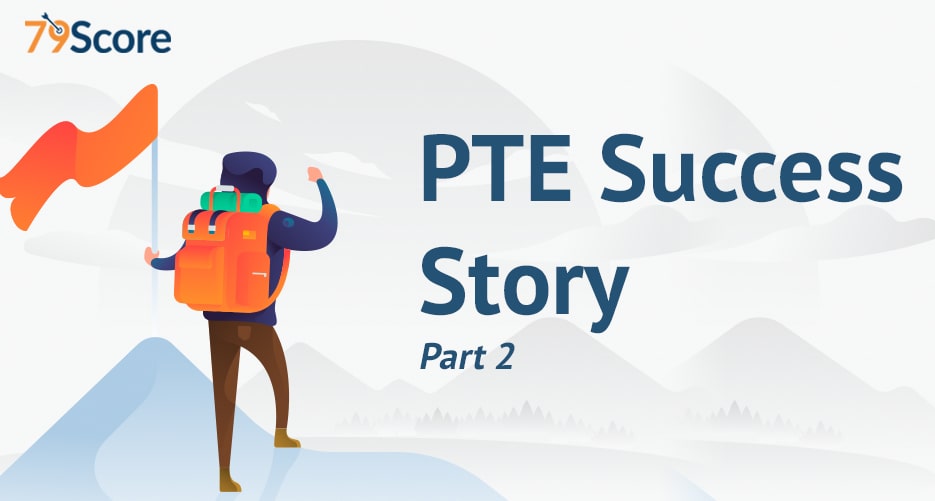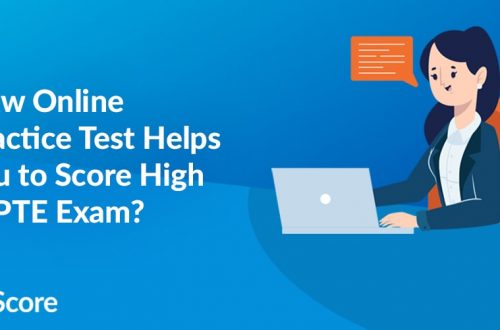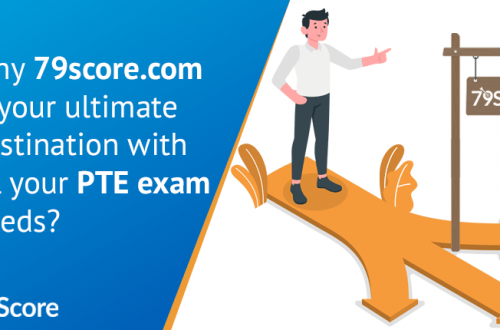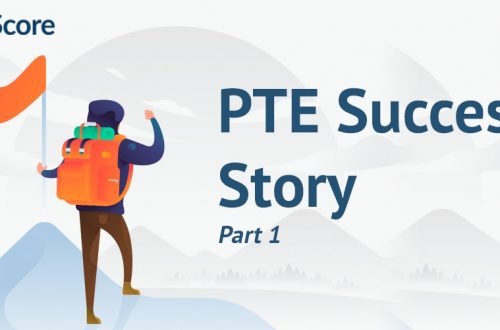Earlier in the first part of PTE Academic success story – A journey to achieve 79+ score, I have mentioned about PTE format and five general strategies for PTE Academic Success. In this part, I am covering my preparation to get 79+ in PTE Exam.
My preparation:
For the Speaking section:
I have decided my pace (not that of total oral fluency as per definition of PTE) would stay on the same level throughout the section. Throughout the speaking section, your fluency should remain the same. Be it RA, RS, DI, RL, ASQ. In other words, the pace/speed of your speech in every section has to be the same as possible. For instance, you may speak RA in a usual manner, as you talk in day to day life, while in DI, RS, and RL you might speak in a bit of hurry, because of time stipulation or memory issues or whatever. And lastly, the tone/volume (high /moderate/low pitch) of the speech has to be similar throughout the section. People try and speak too fast and loudly, that I was not comfortable with. Rather, I opted for a slightly lesser speed than usual (day to day conversation) and the tone I kept where the mike could hear and record me, and not that one which my neighboring test taker would also hear/distract by.
One thing I would like to add is, to record every section at one go, whenever you are practicing, and be critical about the same and try to find variation within that one full test. E.g. Record and practice on the PTE 79score.com the 1st test of the full speaking section and then try to listen to all your recordings and be analytical about it. The critical aspect is that the pace and tone throughout the section should be as similar as possible. Save these recordings and compare them in the future with the recent most recordings, this will certainly give an appropriate way to rectify in an optimum manner.
- RA – Be normal, even a word or two you might not know, just speak as if you know that word, you might lose a fraction of marking if it was wrong, on the other hand, if you try and master and speak in some weird tone with the uncomfortable tone, the chances are you end up hampering your overall speaking score by doing this. You get a score on content, pronunciation, and oral-fluency in this section, be sure you read the score guide of PTE, it is very important to know the details.
The strategies I opted for Read Aloud (RA) were inspired from the 79score.com:
1st speak in chunks. Like one can break the one-sentence into several chunks, take a very little pause in between those chunks and start a chunk with a little higher tone(not loudly) and end a chunk with a lower tone.Stress some of the important words in the paragraphs, by speaking them in a slightly higher tone than your usual tone while reading out the paragraph. Be confident, even if a minor mistake here and there. I had two minor fumble/misplacing of a word in RA speaking, but I scored 83 in speaking. So keep on going, and leave a mistake done there itself. Do not let that affect you after that.
One advice to use the time of 20 seconds only, after you complete your 5 RAs, is that, not press the next button, and indulge in some breathing exercise for 20 seconds maximum and then go for the 6th RA. Anyways minimum RA has been 6 in general. This one would help you tremendously to recollect your strength and get yourself prepared especially for DI and RL. Purely optional, but very much advisable.
One more aspect I felt and it is purely my interpretation but doesn’t cause any damage if you follow the same. While all of your RAs are going to end, well before your stipulated 40 seconds, I have advised you not to press the next immediately. Rather, wait for the recording instruction on the screen to tell you that your recording is completed. I will explain this. Mainly what happens is, once you stay silent for more than 3 seconds, it stops recording, and whatever you have said thus far only gets recorded. Now, what I did was let the recorder do its task up till my RA is finished, and then let it go to an end after I stayed silent for 3 seconds, rather than hitting the next button. What happens is while you were reading the text aloud it (recording progress) was going slowly, and when you remained silent for more than 3 seconds after your RA was over it runs at the right-hand side and says your recording is finished. THIS ALL IN ALL IS JUST MY POINT OF VIEW, NOTHING ELSE.
- RS – I wasn’t good at this task initially. I practiced every day (at least 10 RS and 10 WFD), to get myself decent enough ready for the same. The plan should be spoken in the same manner as you did in RA, and stress so much and not to pause when not required. For instance, you don’t remember one of the chunks of the Repeat Sentence(RS), then leave it, say as much you can recollect.
Do not stress too much. Just speak with the same confidence as in RA. Try to be calm, as RS would usually be 10-12, and would not be in too much length. Just one/two would be a bit lengthier, and mostly would smaller ones.
Practice from 79score.com, they are having nice blogs on this, and also, PTE question-wise practice from their platform is a must for every section. Just you need to login or sign up to the website.My strategies were to listen to the full sentence attentively and repeating in phrases inside my head as much as I hear, while the sentence recording is on. And then to reproduce while the mike starts to record our voice/response.
This could be achieved after lots of practice and daily practices to be precise.
- DI – Describe Image section has a decent weightage in speaking score. You get scored on content, pronunciation, and oral-fluency in this section. If I had to tell you about my marks, they aren’t good at pronunciation (71) and oral-fluency (64), but in speaking I scored a decent score (83). That depicts one picture that, I must have scored good in content, then only I could achieve this overall speaking score. Content is important, but not at the expense of pronunciation and oral-fluency. If I had to tell you about my routine and preparation patterns, all I concentrated on speaking is on pronunciation and oral-fluency, and still, I couldn’t score more on it. Yet, it remains the main focal point for all your efforts. Never undermine these. The content you will get improved on by your daily practices. And surely you will get there, don’t worry.
Now, coming to a very crucial part- “FORMAT”. I didn’t follow any format as such, but a pattern rather. Words may differ, but sequencing should be similar. For the same, 1st speak about the kind of image, that’s a bar graph, pie chart, line chart, combination of those, a picture, etc. Then start talking about what is in it. Like you can straight away go to the trend or max-min, and then finally when only 1/4th part of your timing is remaining, start with your conclusion. The conclusion has a very important role in this. Say anything in conclusion, if you find it confusing or stuck. You may give out max and min again by using different vocabulary, like the highest/lowest, biggest/smallest, max/least, etc. Do not over try and use high-vocabulary words. You may just keep it as simple as possible.
Some of the standard vocabulary you can use:
Illustrates, elucidates, depicts, demonstrates, describes, shows, denotes, and vividly explains.This vertical/ horizontal bar graph depicts the information about the……………………
over the period of……………years. The data is calibrated in terms of ……………………
As it is visible from the bar graph that……………………………
Overall, it can be said that………………………………………………………………………………
This vertical/horizontal bar graph illustrates the information about the…………………
over the period of……………….years. The data is calculated in terms of……………..
It is crystal clear from the bar graph that…………………………………………………………..
…………………………………………………………………………………………………………………..
…………………………………………………………………………………………………………………..
To conclude, it can be said that……………………………………………………………………….
Follow the sequence like:
What kind of graph it is. i.e. line graph/pie chart/bar graph etc.
What is the title of the graph
Timespan i.e. from the year…..to…..
Highest percentage/proportion.
Lowest percentage/proportion.
Use the specific vocabulary of the graph, and make your own after preparing for some days.
One had to practice thoroughly before the exam to master this section.Concentrate more on the same fluency as you may maintain in an earlier section, and do not try and run through the data. Keep speaking at a normal rate, and you will certainly get a good score. My strategy has been to keep things simpler, just follow 79score.com blogs, and keep on improving. And do at least 10 DIs daily, that will put your words in place and you will end up mastering it real soon.
Never stop speaking before 35 seconds.
- RL – Retell lecture score goes in both Speaking as well as Listening, so you should be bang-on with this task. To start, this task is all about listening carefully and taking down notes. Try and use abbreviations while noting down the important aspect of the lecture. Emphasize keywords, as that is the most critical while achieving the 79 scores.
Here the format should be used wisely. Do not overemphasize but it is always advisable to use a format like the below one, which was shared by one of the group members (SNS) while I was preparing for PTE.
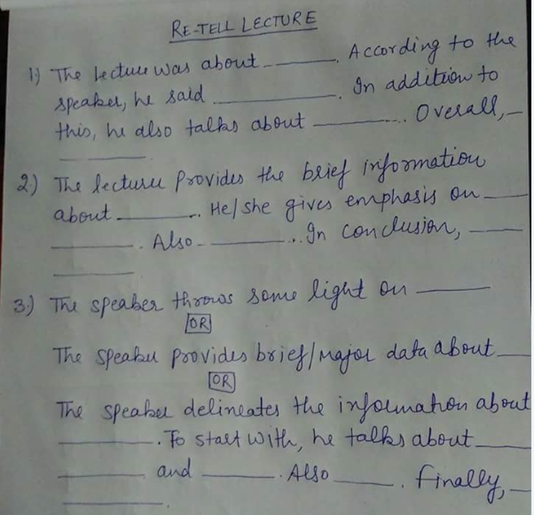
There is no standard as to how it will come, but in general, it has been on medical, science, general life, and so on. If you could not understand some of the words in the lecture, then don’t get stressed out. It is all fine if you just maintain the pace and tone the same as previous sections and keep on talking relevant stuff. Missing one or two things will not impact much. Try and concentrate on listening to the audio/video and stay absolute calm.
While answering, you should know how much you would be able to speak out in a grammatically correct manner in the given 40 seconds. This could be developed while preparing and treat this as very important. All the PTE material RL has to be practiced thoroughly. It is all about skillful note-taking skills and a smooth retelling from your side.
For instance, some topics or lectures would be lengthy, and to reproduce in 40 seconds would sound a bit cumbersome. My advice is not to stress and focus on the best parts you could speak and start speaking with all the confidence you have.
Never stop speaking before 35 seconds.
For those who have exams lined up in the coming next month or even more, they should try and watch English news channels, Hollywood movies, podcasts and alike (Note: all of these without subtitles). This would certainly help in your grasping capabilities.
- ASQ – Answer Short Question(ASQ) is more of general knowledge. I would prefer not to devote too much time to this. They would ask a simple general knowledge question. Mind it a simple question. Strategy while this section is on, is simple: stay focused on the hearing part and give answers as soon as your mike starts. Do not get freaked out on this section, as this is not that highly marked for your overall speaking score. I gave three wrong/uncertain answers. So, just relax, and give as much as you could remember and give answers to common sense kinds of questions.
CAUTION: Do not take lightly, and practice some of the questions. Just that, the time devotion requirement is not that big.
For the Writing Section:
The general opinion is one should follow the format in both the question types in the PTE writing section and I did the same. Try and build your format by referring to the available formats on the internet and other places. Do not try and use so many fancy words, unless you find yourselves comfortable in it, and yes to spell it correctly. And the use of simpler sentences is advisable unless you are so good with grammar. As grammar cannot be learned overnight and you need to learn it before taking up PTE A. It is a kind of prerequisite before the exam. Hence, be sure and use your common English words, which you are very much used to and also confident about the spell of the same.
Enjoy the writing section in general, as you might have formats for all the question types. You can follow these: How to Give Answers for the PTE Writing Section like a Pro. SWT, Essay, and SST all have formats. So, to achieve 79 is easier as per my understanding of writing.
- SWT – This question type has two to three questions for 10 marks each. And this is not a difficult task. You need to summarize a paragraph in a single sentence. Yes! one, complete sentence. There should be one full-stop at the end that’s it! Mind well, here punctuations are really important. Feel confident before the task and be very alert while you read the full text. Try and capture important words/sentences and use that in your summary. The text has to be 5-75 in length. If I had to advise, it should be 30 to 40 words in length. This is going to get accomplished if you stick to your simple strategy of finding keywords and finding important and crux parts of the text. This could be developed by reading newspapers or news articles on the internet and develop the habit of summarizing it in your brain and develop this throughout the preparation time.
Practice in this section is a must, at least 20 Summarize Written Text(SWT) should be practiced. Try and use some vocabulary words such as cohesive devices; furthermore, moreover and all, in the text. This would shoot up your vocab score. Again, no fancy words, I mean. For example, the “younger generation“ is a phrase you want to replace, then you can use teenagers, young ones, today’s’ generation, likewise.
Do not follow any ready-made format in the SWT questions. Big no!
- Essay – Essay topics are mostly available to everyone. I suggest everyone should try and write at least 3 essays a week, and develop the habit of paraphrasing and writing on any abstract topic. After writing on the notepad, paste it in a word file, and see all your mistakes and mark them and commit yourself not to repeat those. Especially spell check is a must. Usually, you would speak a word more often, but that word you cannot write it in the correct spelling. Keep a record of all your essay writing and revisit those and recheck for a spell and write down the spelling again and again until you master it. Spelling in the Writing section plays a big role.
Many formats are available for essay writing. Use the one you feel is best suited and remembered by you. After all, the content is also very important in essay writing.
I followed the below:
Para no. one: the topic… Some people say this……, while others say that… I am inclined to believe that… I shall elaborate/explain my viewpoint in the following paragraphs.Para no, two: First of all…. For instance….
Para three: Second of all……. For example…
Para Four: In conclusion, based on the above illustrations, one could safely say that….. Moreover, everyone should take the positives out of the…..
Again, what is more, important is to deal with the prompt very accurately and in totality. Whether it is asking to take your stance, or it is asking the general view, or want to discuss both sides. (these three types)
The ideal length as per my understanding is 240-260 words on approximation.
If you are following the format, then try and use different formats (may change slightly here and there) for all the essays. Do not follow the same for all the essay type questions. Big no. In most cases it is just one essay, no more headache, I guess.
I will cover the preparation of the remaining two sections of the PTE exam in the next part. One who is looking for PTE mock test online at the best price at 79score.com with free 1 mock tests and the lowest price in India.
You can read my third part of PTE Academic Success Story – A Journey to Achieve 79+ Score (Part-3) here.
Please give me a comment below what you thought about this part.
|
79Score
|
